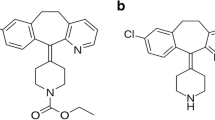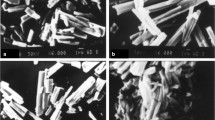Abstract
Purpose. To understand the influence of polymorphic structure on the tableting properties of sulfamerazine.
Methods. Bulk powders of sulfamerazine polymorph I and of two batches, II(A) and II(B) of different particle size, of polymorph II were crystallized. The powders were compressed to form tablets whose porosity and tensile strength were measured. The relationships between tensile strength, porosity and compaction pressure were analyzed by the method developed by Joiris, E., et al. Pharm. Res. 15:1122-1130 (1998).
Results. The sensitivity of tensile strength to compaction pressure, known as the tabletability, follows the order, I >> II(A) > II(B) and the porosity at the same compaction pressure, which measures the compressibility, follows the order, I << II(A) < II(B). Therefore, the superior tabletability of I over II(A) or II(B) is attributed to its greater compressibility. Molecular simulation reveals slip planes in crystals of I but not in II. Slip planes provide I crystals greater plasticity and therefore greater compressibility and tabletability. Larger crystal size of II(B) than of II(A) leads to fewer contact points between crystals in the tablets and results in a slightly lower tabletability.
Conclusions. Slip planes confer greater plasticity to crystals of I than II and therefore greater tabletability.
Similar content being viewed by others
REFERENCES
D. J. W. Grant. Theory and origin of polymorphism, In H. G. Brittain (ed.), Polymorphism in Pharmaceutical Solids, Marcel Dekker, Inc., New York, NY, 1999 pp. 1-34.
U. Conte, P. Colombo, C. Caramella, G. P. Bettinetti, F. Giordano, and A. La Manna. On the direct compression of sulfamethoxydiazine (SMD) polymorphic forms—I. Il Farmaco (Ed. Pr.) 30:194-206 (1974).
M. Otsuka, H. Hasegawa, and Y. Matsuda. Effect of polymorphic transformation during the extrusion-granulation process on the pharmaceutical properties of carbamazepine granules. Chem. Pharm. Bull. 45:894-898 (1997).
M. Otsuka, T. Matsumoto, S. Higuchi, K. Otsuka, and N. Kaneniwa. Effect of compression temperature on the consolidation mechanism of chlorpropamide polymorphs. J. Pharm. Sci. 84:614-618 (1995).
M. D. Tuladhar, J. E. Carless, and M. P. Summers. The effects of polymorphism, particle size and compression pressure on the dissolution rate of phenylbutazone tablets. J. Pharm. Pharmacol. 35:269-274 (1982).
M. W. Y. Wong and A. G. Mitchell. Physicochemical characterization of a phase change produced during the wet granulation of chlorpromazine hydrochloride and its effects on tableting. Int. J. Pharm. 88:261-273 (1992).
T. Yamaoka, H. Nakamachi, and K. Miyata. Studies on the characteristics of carbochromen hydrochloride crystals. II. Polymorphism and cracking in the tablets. Chem. Pharm. Bull. 30:3695-3700 (1982).
G. Nichols and C. S. Frampton. Physicochemical characterization of the orthorhombic polymorph of paracetamol crystallized from solution. J. Pharm. Sci. 87:684-693 (1998).
R. J. Roberts, R. S. Payne, and R. C. Rowe. Mechanical property predictions for polymorphs of sulphathiazole and carbamazepine. Eur. J. Pharm. Sci. 9:277-283 (2000).
M. R. Caira and R. Mohamed. Positive identification of two orthorhombic polymorphs of sulfamerazine (C11H12N4O2S), their thermal analyses and structural comparison. Acta Cryst. B48:492-498 (1992).
G. G. Z. Zhang. Influences of Solvents on Properties, Structures, and Crystallization of Pharmaceutical Solids, Ph.D. Thesis, University of Minnesota: Minneapolis MN, 1999, pp. 127-178
G. G. Z. Zhang, C. Gu, M. T. Zell, R. T. Burkhardt, and D. J. W. Grant. Crystallization and transformation of sulfamerazine polymorphs. J. Pharm. Sci. Submitted (2001).
K. R. Acharya, K. N. Kuchela, and G. Kartha. Crystal structure of sulfamerazine. J. Crystallogr. Spectrosc. Res. 12:369-376 (1982).
E. N. Hiestand and C. B. Peot. Tensile strength of compressed powders and an example of incompatibility as end-point on shear yield locus. J. Pharm. Sci. 63:605-612 (1974).
R. W. Heckel. Density-pressure relationships in powder compaction. Trans. Metall. Soc. AIME 221:671-675 (1961).
R. W. Heckel. An analysis of powder compaction phenomena. Trans. Metall. Soc. AIME 221:1001-1008 (1961).
J. A. Hersey and J. Rees. Deformation of particles during briquetting. Nature (Phys. Sci.) 230:96 (1971).
E. Joiris, P. D. Martino, C. Berneron, A.-M. Guyot-Hermann, and J.-C. Guyot. Compression behavior of orthorhombic paracetamol. Pharm. Res. 15:1122-1130 (1998).
E. Ryshkewitch. Compression strength of porous sintered alumina and ziroconia. J. Am. Cer. Soc. 36:65-68 (1953).
R. J. Roberts, R. C. Rowe, and P. York. The relationship between the fracture properties, tensile strength and critical stress intensity factor of organic solids and their molecular structure. Int. J. Pharm. 125:157-162 (1995).
P. York. Particle slippage and rearrangement during compression of pharmaceutical powders. J. Pharm. Pharmacol. 30:6-10 (1978).
Author information
Authors and Affiliations
Rights and permissions
About this article
Cite this article
Sun, C., Grant, D.J.W. Influence of Crystal Structure on the Tableting Properties of Sulfamerazine Polymorphs. Pharm Res 18, 274–280 (2001). https://doi.org/10.1023/A:1011038526805
Issue Date:
DOI: https://doi.org/10.1023/A:1011038526805




